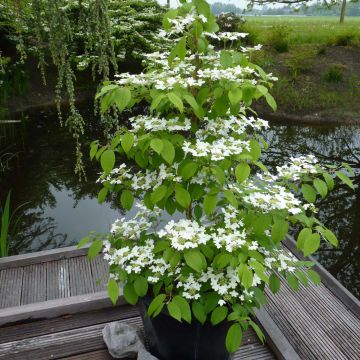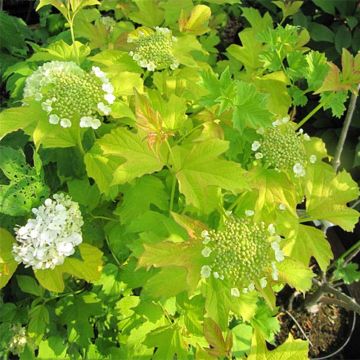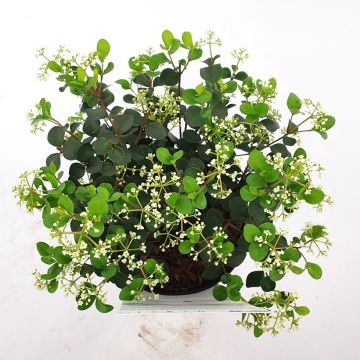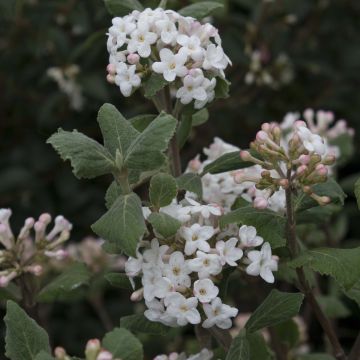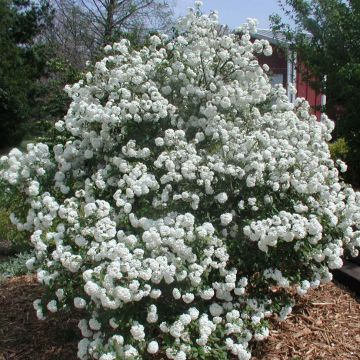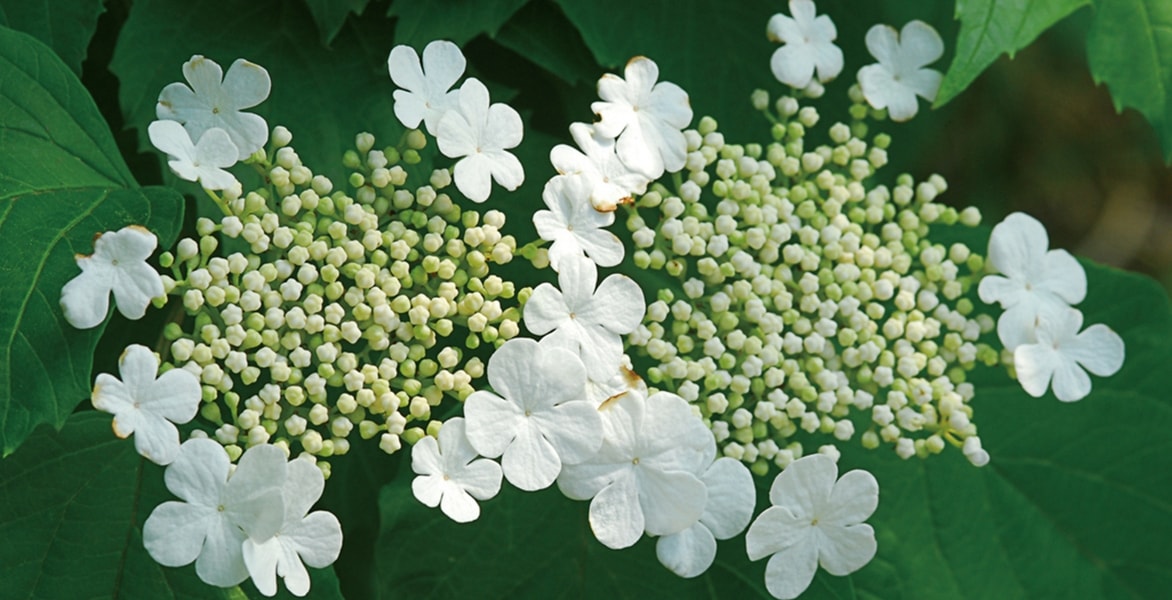
Viburnum, Viorne: planting, pruning and growing
Contents
Viburnum in a nutshell
- Viburnum has everything to please: a generous flowering, decorative berries, and foliage that takes on stunning hues in autumn, sometimes even evergreen! It is interesting in every season.
- It thrives in all gardens: grow Viburnum tinus (Laurustinus) as a hedge or in a pot, Viburnum plicatum as a specimen plant, and Viburnum opulus (Guelder-rose, Snowball) in a border.
- With its winter or spring flowering, Viburnum helps to lift the gloom and grey of winter!
- It offers an abundant flowering in soft shades, white with a hint of pink, which can resemble snowballs.
- Very hardy and easy to grow, it requires little maintenance!
A word from our Expert
Decorative both for their delicate flowerings, their colourful berries, and their leaves — which often take on stunning shades in autumn — Viburnum have everything to please! In winter or in spring, they enhance borders with their generous white or pink flowering. Once this is over, the red, black, or blue berries create a new attraction in the garden and attract birds. And when autumn arrives, the leaves of the deciduous species adorn themselves with sumptuous red or orange colours. This is the case for Viburnum opulus (Guelder rose), Viburnum lantana, and Viburnum plicatum. As for the evergreen species, such as Viburnum tinus (Laurustinus), Viburnum davidii, or Viburnum rhytidophyllum, they retain their foliage and remain decorative in winter! Planted as a hedge, they will create a green screen that hides from prying eyes during the cold season.
Rather easy to grow, Viburnum require little maintenance. Most are very hardy and thrive in sun or partial shade. They appreciate rich, cool, and well-drained soil. They can generally adapt to any type of soil but prefer acidic grounds. Particularly resistant to pollution — especially Viburnum opulus, Viburnum tinus, and Viburnum davidii — Viburnums can be planted in urban and polluted environments.
Viburnum tinus ‘Eve Price’ or Viburnum lantana are perfect for integrating into a living hedge with other deciduous or evergreen bushes! As for Viburnum plicatum and Viburnum opulus ‘Roseum’ (also known as Snowball), they have such impressive flowerings that they will make a very beautiful effect if planted alone, for example in the middle of a short grass meadow. Use the other species to compose a shrub border.
Botany
Botanical data
- Latin name Viburnum sp.
- Family Adoxaceae
- Common name Viburnum
- Flowering winter or spring
- Height from 1 to 5 m
- Exposure sun or partial shade
- Soil type humus-bearing, cool, well-drained
- Hardiness -15 to -20 °C for most species, and -10 °C for Viburnum tinus
Viburnums, or Viburnum, comprise nearly 200 species of bushes, as well as a few trees. The most well-known are undoubtedly the Laurier tin (Viburnum tinus) and the Viorne obier (Viburnum opulus, also known as Snowball). They are interesting for their spring or winter flowering, their decorative berries, and their foliage, which can take on beautiful hues in autumn.
They currently belong to the Adoxaceae family, a small family that includes elderberries. However, they were previously classified in the Caprifoliaceae family, along with honeysuckle (botanists love change!). Viburnums are native to the temperate regions of the Northern Hemisphere (Asia, Europe, North America). Many species can be found in Asia, mainly in China, such as Viburnum davidii. The Viorne obier (Viburnum opulus), the Viorne lantane (Viburnum lantana), and the Laurier tin (Viburnum tinus) grow naturally in France. The Viorne obier is found in wet forests and hedges, while the Laurier tin is native to the Mediterranean region.

Inflorescence, fruiting, and foliage of Viburnum
The name Viburnum is thought to come from the Latin viere, meaning to weave or bind, as the branches are flexible and can be woven into ties. The Viorne lantane (Viburnum lantana) can thus be used in basketry.
Most Viburnums form bushes that vary in height from two to four metres. Some, like Viburnum lantana, can even reach five metres tall. There are also dwarf varieties, such as Viburnum opulus ‘Compactum’ or Viburnum davidii: very handy if you’re short on space in your garden! With its very low and spreading habit, Viburnum davidii can be used as ground cover. The Chinese Viburnum, Viburnum plicatum, has horizontal branches that give it a remarkable tiered habit.
Many species flower in spring (most in May and June): this is the case for Viburnum lantana, Viburnum davidii, Viburnum plicatum, Viburnum opulus, Viburnum x burkwoodii, and Viburnum rhytidophyllum. As for Viburnum x bodnantense and Viburnum tinus (Laurier tin), they flower in winter, usually between December and March, sometimes even as early as November for the latter. They help us wait for spring by bringing their delicate flowering to the garden when it is lacking in flowers!
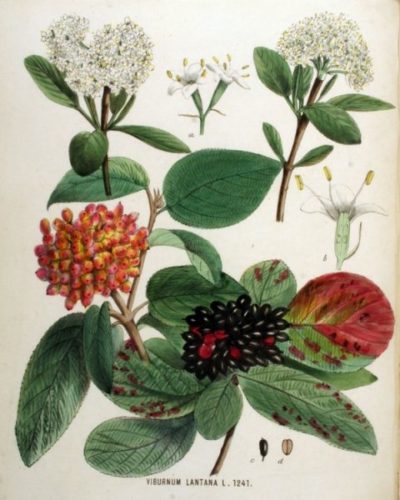
Viburnum lantana, botanical illustration
The flowers of Viburnums have a very pure and soft hue. They are white, with varying shades of pink. Gathered in large flattened inflorescences — reminiscent of those of hydrangeas — or spherical, they take on the appearance of snowballs! This is the case for Viburnum opulus, which is nicknamed Snowball Viburnum. These inflorescences contain a multitude of small five-lobed flowers. They are very lightly scented. However, some species are known for their strong fragrance: this is the case for Viburnum carlcephalum and Viburnum x burkwoodii. The flowers are melliferous and attract pollinating insects.
Viburnums have simple leaves, with often very pronounced veins. The edges of the leaves are sometimes dentate. The Viorne obier (Viburnum opulus) is remarkable for its beautiful three-lobed leaves! Those of Viburnum rhytidophyllum are surprising due to their wrinkled, crinkled appearance, due to their extremely pronounced veins!
The foliage is deciduous in Viburnum bodnantense, Viburnum plicatum, Viburnum opulus, and Viburnum lantana, and takes on magnificent hues in autumn, often red, orange, or purple. It is semi-evergreen in Viburnum ‘Le Bois Marquis’ or V. hilieri ‘Winton’, which sees its foliage regenerate in spring with beautiful bronze colours in spring, then dark green in summer, finishing with coppery red in winter. As for the evergreen species, they allow for the creation of a bed that remains green even in the middle of winter! This is the case for Viburnum tinus, Viburnum davidii, Viburnum x burkwoodii, and Viburnum rhytidophyllum. Also discover the superb golden yellow foliage of Viburnum lantana ‘Aureum’!
After flowering, Viburnums are adorned with decorative berries. They are generally red or blue and sometimes turn black at maturity. They will attract birds to the garden! The Viburnum opulus ‘Xanthocarpum’ is a variety appreciated for its superb bright yellow berries. To encourage fruiting, it is necessary to group several plants of the same species, especially if you are planting Viburnum davidii, which is dioecious.
Most viburnums are perfectly hardy. This is the case for Viburnum opulus, Viburnum x bodnantense, and Viburnum rhytidophyllum, which can withstand temperatures down to -20 °C. The Laurier tin (Viburnum tinus) is the least hardy species: down to -10 °C.
Discover the superb Viburnum hilieri ‘Winton’ in video:
Species and varieties of Viburnum
There are more than 200 spieces and 300 varieties of Viburnum. Botanical species are frequently used for their ornemental, but also ecological qualities.
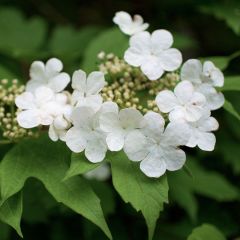
Guelder rose - Viburnum opulus
- Flowering time June, July
- Height at maturity 3,50 m
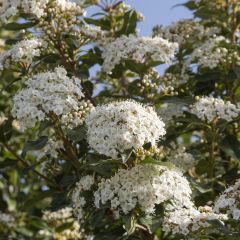
Viburnum tinus - Laurustinus
- Height at maturity 2,50 m
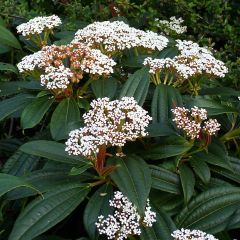
Viburnum davidii - David viburnum
- Flowering time July
- Height at maturity 1 m
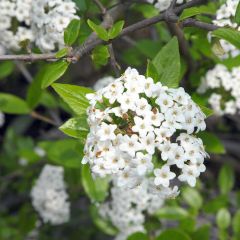
Viburnum burkwoodii
- Flowering time May, June
- Height at maturity 2,50 m

Viburnum lantana
- Flowering time May to July
- Height at maturity 3 m
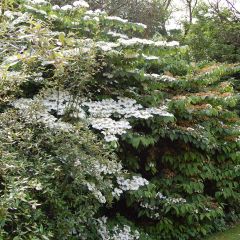
Viburnum plicatum Lanarth
- Flowering time June, July
- Height at maturity 3 m
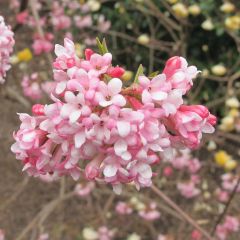
Viburnum bodnantense Dawn
- Height at maturity 2,50 m
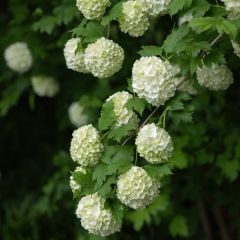
Snowball Viburnum - Viburnum opulus Roseum
- Flowering time June, July
- Height at maturity 3,50 m
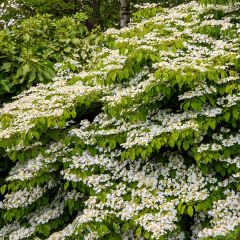
Viburnum plicatum Mariesii Great Star
- Flowering time June, July
- Height at maturity 2,50 m
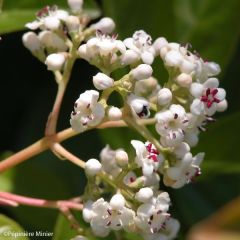
Viburnum Le Bois Marquis
- Flowering time June, July
- Height at maturity 2,50 m
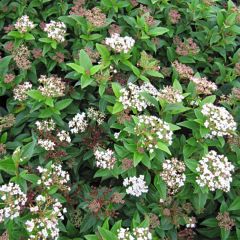
Viburnum tinus Eve Price
- Flowering time February to May
- Height at maturity 2 m
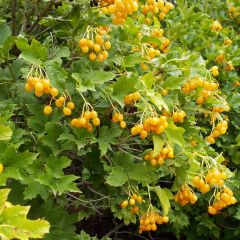
Viburnum opulus Xanthocarpum
- Flowering time June, July
- Height at maturity 2 m
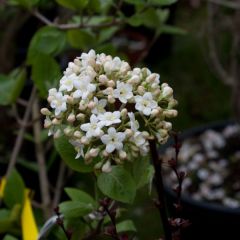
Viburnum x carlcephalum
- Flowering time June, July
- Height at maturity 3 m
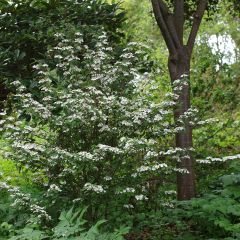
Viburnum plicatum Kilimanjaro Sunrise
- Flowering time June, July
- Height at maturity 1,60 m
Pour bien choisir votre Viorne, découvrez notre fiche conseil : “Viburnum : quelle variété choisir ?”
Enregistrer
Enregistrer
Enregistrer
Enregistrer
Discover other Viburnum
View all →Available in 3 sizes
Available in 2 sizes
Available in 1 sizes
Available in 1 sizes
Available in 4 sizes
Available in 2 sizes
Available in 1 sizes
Available in 4 sizes
Available in 2 sizes
Available in 1 sizes
Planting Viburnum
Where to plant?
Viburnums adapt to different types of soils and tolerate heavy, clayey ground. Plant them in rich soil that remains moist in summer and preferably well-drained. When planted in light, deep soil, your Viburnum will be much less likely to fall ill, particularly from phytophthora! Avoid overly hot and dry conditions (especially for Viburnum opulus), as well as waterlogged soils in winter! You can also create drainage by adding gravel or clay balls during planting.
Most species prefer to be planted in partial shade. However, some viburnums, such as Viburnum tinus, Viburnum x burkwoodii, and Viburnum lantana, prefer full sun.
Viburnums favour neutral to acidic soils. A few can tolerate calcareous soils, such as Viburnum lantana, Viburnum tinus (laurel tin), and Viburnum sargentii.
For evergreen species, choose a location sheltered from the wind, especially if you live in a cold climate. However, laurel tin tolerates wind and sea spray well and thrives by the seaside.
Finally, you can also plant certain species in large pots or containers. For this purpose, choose Viburnum tinus ‘Eve Price’ or Viburnum davidii.
Of all the Viburnums, laurel tin is undoubtedly the least demanding. It is easy to grow and adapts to various situations. It is the ideal bush for beginner gardeners!
When to plant?
Plant deciduous varieties preferably in autumn, in October or November. Opt for early spring (March-April) for evergreen varieties, which are more sensitive to severe winter frosts.
How to plant?
Plant Viburnums in groups to obtain decorative fruits! This will encourage pollination and subsequent fruiting, especially in certain species like Viburnum davidii. Generally, you will get more decorative berries if several plants are planted together.
When planting in a hedge, space the viburnums at least 80 centimetres apart from other bushes, and 4 to 5 metres if you are planting them individually. This will give them enough room to develop properly.
Add some heather soil if you are planting David’s Viburnum (Viburnum davidii). Unlike Viburnum lantana, it prefers acidic soils!
Start by moistening the root ball by placing it in a basin filled with water, to encourage recovery and facilitate subsequent watering. Dig a planting hole two to three times larger than the root ball. This is important for the development of its root system! Replace some soil and potting mix at the bottom of the hole. Add a few handfuls of compost. Place the root ball. Be careful not to bury it too deep: the collar should be level with the soil, or even slightly above. Replace the soil around the root ball and firm the soil. Water generously. You can stake the plant if necessary.
Continue to water during the first weeks after planting. During the first few years, water in case of summer drought. This will give the viburnum time to settle in and develop its roots to become more drought-resistant.
→ Also discover our advice sheet: Growing a viburnum in a pot and Diseases and pests of viburnums
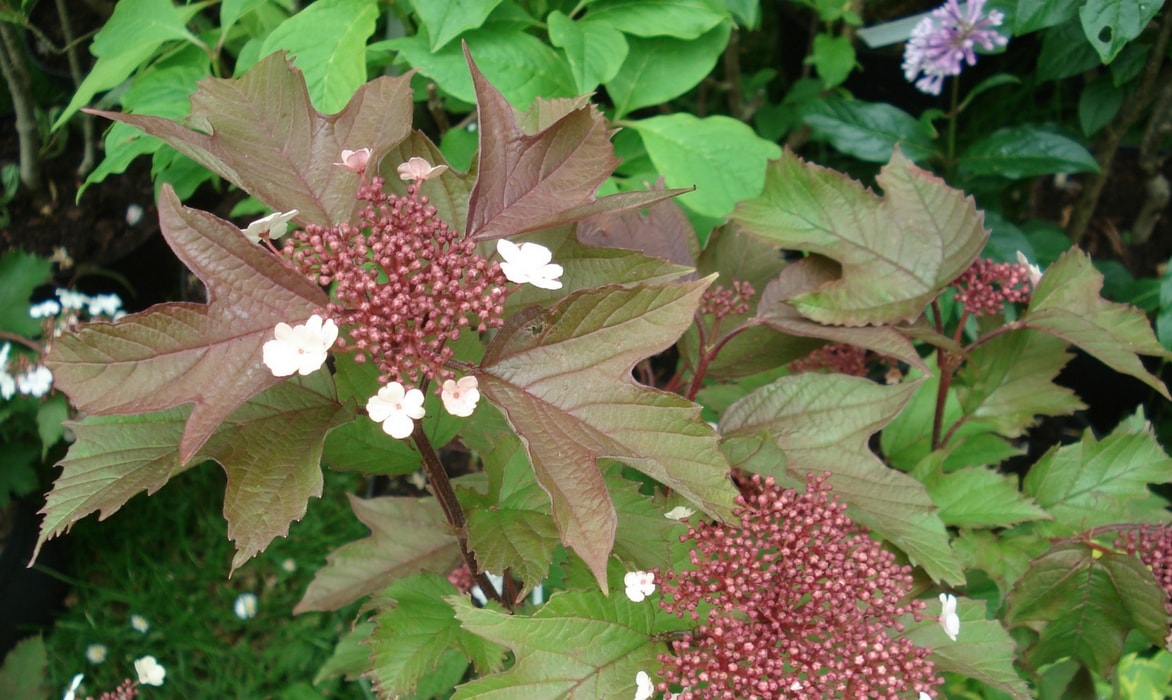
Viburnum sargentii ‘Onondaga’
Maintenance
We suggest mulching viburnums to keep the soil cool during summer. However, Viburnum opulus and Viburnum x burkwoodii tolerate drought quite well. Mulching can also provide additional protection for winter.
Viburnum prefers rich soils: it is rather greedy for nutrients. To promote their growth, apply fertiliser or compost every spring. Weed, place a few handfuls of slow-release fertiliser or a layer of compost (2-3 cm) at the base of the bush and incorporate it by scratching the soil.
Viburnums are susceptible to several diseases and pests. They can be attacked by aphids, weevils, and the Viburnum beetle (Pyrrhalta viburni). Otiorhynchus sometimes consume the leaves. Discover everything you need to know about the otiorhynchus.
They are also sensitive to black spot disease and armillaria. Laurel tin (Viburnum tinus) is susceptible to whiteflies, and Viburnum davidii to phytophthora. (learn more about the diseases and pests of the laurel tin).
Discover how to prune viburnums in our tutorial.
Phytophthora and black spot disease are caused by a fungus, avoid excess water and add a layer of gravel or clay balls when planting to facilitate drainage. To keep your Viburnum healthy and protected from these diseases—especially Viburnum plicatum, which is particularly sensitive—it is important to plant them in light, deep and non-calcareous soil!
Pruning
It is not always necessary to prune viburnums. You can do so to maintain a harmonious shape and remove any dead or damaged branches. Prune in spring, after flowering, on plants that are at least three or four years old. Carry out rather light pruning on evergreen species. Deciduous varieties tolerate heavier pruning better, and it is possible to cut them back. We suggest only pruning when necessary, especially if you want to have fruit in autumn. Pruning after flowering will limit the appearance of decorative berries. Viburnums sometimes produce suckers or shoots from the base: if you see any, remove them.
Viburnum lantana and Viburnum davidii do very well with light pruning, which just helps to give them a balanced shape and remove a few dead or poorly positioned stems. As for Viburnum x burkwoodii and Viburnum plicatum, they do not need to be pruned. Laurel tin can withstand quite severe pruning, allowing it to be shaped more elaborately and control its growth when planted in a hedge.
→ Learn more about pruning the laurel tin in our tutorial!
Multiplication
You can multiply your Viburnum by sowing, propagation by cuttings, and layering. We recommend layering as it is the simplest and fastest technique. If you multiply the viburnum, you will need to wait at least two years before planting it permanently in the garden. It is also possible to multiply it by taking and transplanting its suckers: the new shoots that emerge from the soil and develop from the roots.
Sowing
We recommend propagation by cuttings or layering over sowing: you will obtain beautiful young plants more quickly. Multiplying viburnum by sowing is a delicate operation that takes time. Seeds can take a long time to germinate (up to two years). However, viburnum can also reproduce on its own through spontaneous sowing.
You can sow in the autumn or at the end of winter from March, under a cold frame. Generally, we advise you to collect the seeds in autumn and either sow them immediately, removing the pulp surrounding the seeds, or keep them cool throughout the winter to sow them in spring.
Some species, such as the Guelder rose (Viburnum opulus) or the Laurustinus (Viburnum tinus), require warm stratification (20 °C) for one to two months, followed by cold stratification by placing them in the refrigerator for two to three months. This helps to break their dormancy. The Viburnum rhytidophyllum only needs a cold period of three months. You can then sow the seeds in spring.
To stratify the seeds, place a layer of sand in a seed tray. Position the seeds and cover with a second layer of sand. Then cover the seed tray with a plastic bag and place it in the refrigerator.
To sow, fill a seed tray with substrate. Then sow the seeds. Cover with a thin layer of potting soil and press down lightly. Water and place the seed tray under a cold frame. Ensure that the substrate remains moist until germination. You can repot the young plants in spring.
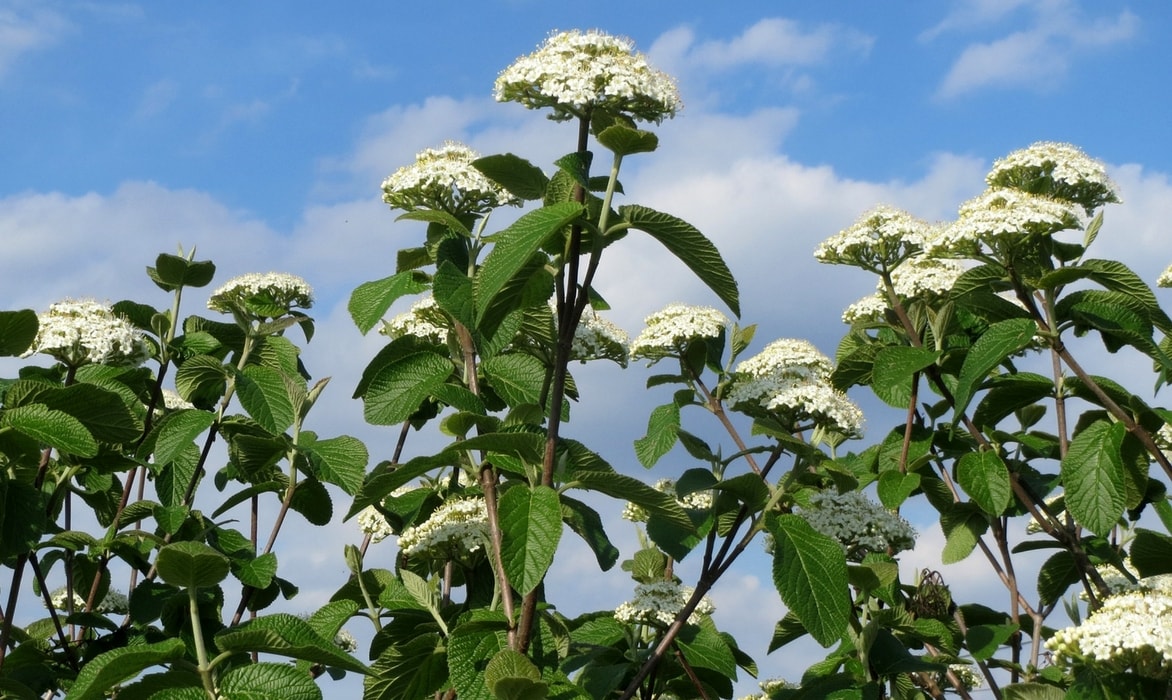
Viburnum lantana
Propagation by Cuttings
Take cuttings of viburnum during the summer, from May to September. This operation is easy to carry out.
You can take softwood cuttings in May or June (preferably for deciduous species, such as Viburnum opulus) or semi-hardwood cuttings from July to September (for evergreen species, such as Viburnum davidii).
Prepare a seed tray by filling it with a mix of potting soil and sand. Water to moisten the substrate. Choose a healthy and relatively young branch. Cut a segment about ten centimetres long using a sharp knife, just below a node (the point where leaves attach to the stem). Optionally remove the lowest leaves. Plant the cutting and press down gently to ensure contact with the substrate. Then ensure that the substrate remains moist. Two months later, you can transfer the cuttings to pots that you will keep under a cold frame for the winter.
Layering
Layering is the easiest technique for multiplying Viburnum. Act in early autumn, in September or October.
Choose a low, long, and flexible branch and bend it towards the ground. Prepare the soil at this location by loosening it, adding some potting soil, and digging a small furrow about ten centimetres deep. Using a sharp knife, make a few incisions on the underside of the branch. Bend the branch to make contact with the soil at the incision site, cover lightly, and hold it in place with a stone. Straighten the end of the branch with a stake. Water. Two months later, you can cut the branch to separate it from the original plant.
Association
With its rustic and natural charm, viburnum is perfect for creating a living hedge! Species with evergreen and dense foliage, such as Laurier tin (Viburnum tinus) or Viburnum rhytidophyllum, will shield you from prying eyes even in the depths of winter. Pair them with Spiraeas, Photinia x fraseri, or Cornel trees.
For a romantic effect, combine Viburnum lantana with other plants in soft tones, such as Deutzias, Kolkwitzias, or Weigelias. And enjoy the fragrant blooms of Mock Oranges or Lilacs!
If your garden is small and you have limited space, choose species that can be planted in large containers on a terrace: this is the case for Viburnum davidii or Viburnum tinus ‘Eve Price’. Plant alongside them some flowers or grasses: Primroses, Muscaris, Hakonechloa macra, or Ophiopogon planiscapus.
If you opt for Viburnum plicatum or Viburnum opulus ‘Roseum’, plant them as specimens. Their exceptional architecture and flowering will be even more highlighted! You can also plant periwinkles, spring bulbs, or perennials at their feet.
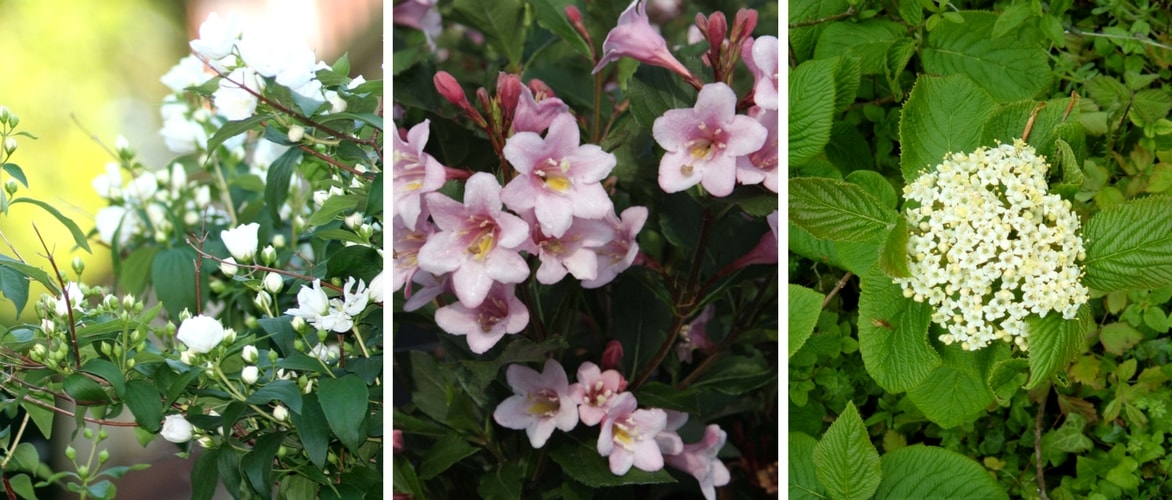
An idea for pairing: Deutzia, Weigelia florida ‘Polka’, and Viburnum lantana
Need a bit more inspiration? Discover our pairing sheets: “Viburnum – 8 successful pairing ideas” and pairing Laurier tin
Useful resources
- Our wide range of Viburnum
- Advice sheet – How to propagate Laurier tin?
- Tutorial: How to create a Laurier tin hedge?
- Discover 6 evergreen viburnums; 5 viburnums to create a hedge; 7 viburnums for small gardens or pot cultivation
- Sheet Planting Perennials and Bushes
- Discover 7 trees and bushes with a nival zone habit
Frequently asked questions
-
My viburnum isn't growing!
After planting, viburnums need time to settle in and start their growth. Be patient if you have planted it recently. If your viburnum is not growing, it may also be a sign of a deficiency in nitrogen, phosphorus, or potassium. Apply slow-release fertiliser or compost in spring to encourage their growth. Laurus nobilis is one of the slowest growing species. It is perfect for small gardens (especially as it tolerates severe pruning)! Viburnum rhytidophyllum and opulus have a much faster growth rate.
-
My viburnum isn't flowering!
This may be due to an excess of nutrients and nitrogen-rich fertilisers: they promote vegetative growth at the expense of flowering. Cut off the supplies! Also, check that the growing conditions are suitable. Too much shade limits flowering. For reference, viburnum prefers to be planted in partial shade or full sun, in cool, well-drained soil. Finally, if you obtained your viburnum through sowing, be aware that you will need to wait several years before seeing it flower.
-
My viburnum is losing its leaves! What should I do?
If the leaves fall in autumn, there is no need to worry! It's the season... If this happens at another time, or if it concerns an evergreen species, your viburnum is likely planted in a situation that is too dry. Water it and apply mulch to maintain moisture at the soil level. Viburnum is sensitive to summer drought, especially during the first few years!
-
The leaves of my viburnum are wilted and curling in on themselves!
If the leaves of your viburnum appear curled, it is likely due to black aphids. Inspect the plant and look for the presence of aphids and ants. Spray a solution made from black soap or nettle manure.
-
There are black larvae on my viburnum! What should I do?
It is certainly the viburnum beetles (Pyrrhalta viburni). They cut the leaves into lace, leaving only the veins. Carefully observe the leaves: if they are cut in this way, manually remove the larvae and the leaves that bear eggs. Spray a natural insecticidal solution based on pyrethrum or a solution made from black soap.
-
My viburnum seems to be lacking water even though the soil is moist!
If your viburnum appears wilted and its leaves are drying out, it is likely suffering from phytophthora. This disease attacks the roots and prevents them from absorbing water and minerals. Consider relocating it to a light, well-draining soil, as stagnant moisture encourages the development of this disease! If it is a compact viburnum, such as Viburnum davidii or Viburnum tinus (laurel viburnum), grow it in a container.
- Subscribe!
- Contents
































